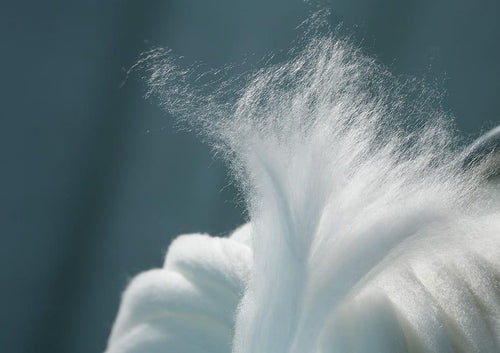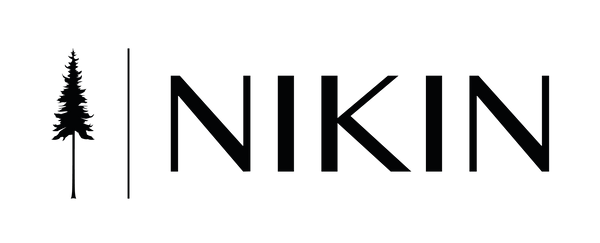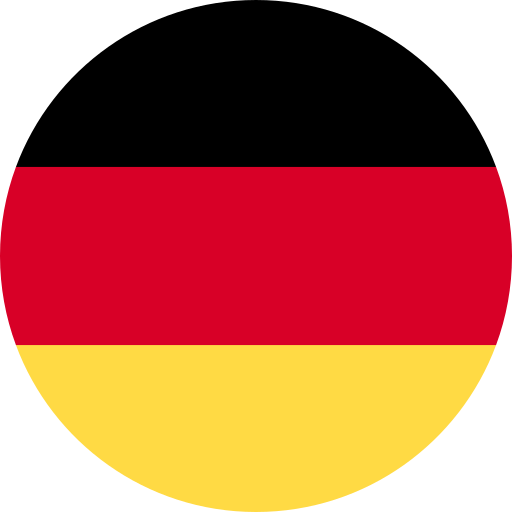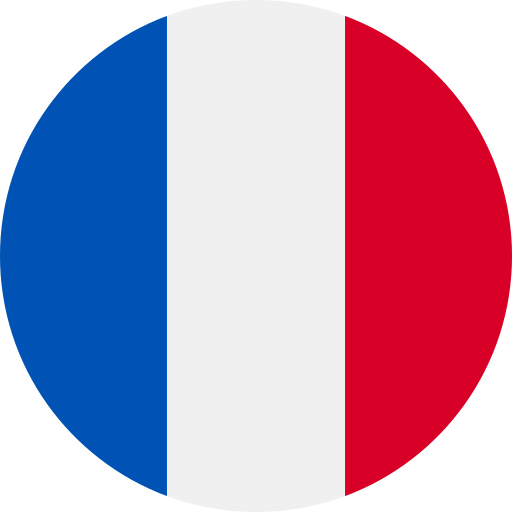Materials
Get to know our textiles better
Are you interested in the materials and textiles used at NIKIN?
Then you've come to the right place. We would be happy to tell you more about the different materials and product elements.
- (Organic) cotton
- Recycled cotton
- Linen
- Nettle (fibers)
- TENCEL™ Lyocell
- Bamboo viscose
- Hemp
- Tree free paper
- naNea by Oceansafe
- NOOSA®
- Sympatex®
- Post-Consumer reTurns
- Merino wool
- Polylana®
- ECONYL®
- SEAQUAL®
- Recycled glass
- Stainless steel
- #tide ocean material®
- Recycled polyester
- Polyacrylic
- Spandex
- Recyclable enamel
- Bio-based Grilamid
- Piñatex®
- Cork
- Ecorubber
Organic cotton and regular cotton
Cotton comes from the seed hairs of the cotton plant, a mallow plant. There are around 21-50 species in subtropical and tropical climates. The textile is considered skin-friendly and hygienic as it can be washed very hot without being dyed. In addition to textiles, cotton is also used for paper, nets and fillers. Findings indicate that we have been processing and using this raw material for 9000 years. Particularly practical: untreated cotton is coated with a layer of wax and is therefore water-repellent. Until the industrial revolution, cotton, like silk, was considered a luxury good, as it was very time-consuming to process the raw material into cotton textiles by hand. Rounded up, half a kilo of cotton took 13 working days to produce back then.
The difference between organic cotton and normal cotton lies in the production process. Organic cotton is produced without pesticides and fertilizers. Other important aspects such as soil fertility, water pollution and working conditions are also taken into account.
What we like about the material: We appreciate the fact that cotton is a pure natural fiber and always try to find an organic cotton manufacturer.

Recycled cotton
Cotton is one of the most popular natural fibers - but its conventional cultivation requires large amounts of water, land and energy. Recycled cotton, on the other hand, offers a resource-saving alternative: instead of growing new cotton, existing cotton waste is reused. Our recycled cotton comes from 100% pre-consumer materials and is mechanically processed using the innovative RCO100® technology from our partner Säntis Textiles - without the addition of new cotton or synthetic fibers.
The result is a high-quality yarn that not only saves water and reduces CO₂ emissions, but also actively supports textile cycles. For our products, we use fabrics with a weight of around 220-230 g/m², which are comfortable to wear and robust. To ensure full circularity, seams and labels are also made of 100% cotton. This makes our products easier to recycle later and conserves valuable resources right from the start.

Linen (-fibres)
Linen fibers come from the cultivated plant true linen. In addition to linen, the group of so-called bast fibers also includes fabrics such as hemp fibers or jute. If the fibers are harvested from the young plant, they are fine; the older the linen is, the coarser the fibers become. Linen is considered to be a breathable textile that allows little bacteria, dirt and dust to adhere to its surface.
This is what we like about the material: we prefer linen because it is a natural fibre and appreciate the fact that its production requires little to no fertilizer or pesticides, even in conventional cultivation.

Nettle (fibers)
Nettles are a fast-growing and renewable resource that can be cultivated without any major ecological impact. Garments made from nettle fibers are not only environmentally friendly, but also extremely functional and have a similar feel to linen or hemp fibers. And like other bast fibres, fabrics made from nettle fibres are characterized by a slightly irregular fabric appearance and a dry feel. The fibers are robust, light and breathable, which makes them ideal for durable and comfortable clothing. They also have natural antibacterial properties that reduce odors and keep clothing fresher for longer. Nettles also require less water and pesticides to grow compared to conventional materials such as cotton and can even be grown on marginal soils that are unsuitable for agricultural use.
That's what we like about the material:
- Sustainability and environmental friendliness
- Robustness and durability
- Lightweight and breathable
- Natural antibacterial properties
- Lower resource consumption and cultivation flexibility

TENCEL™ Lyocell
TENCEL™ Lyocell fibers are produced in a resource-saving, closed production process, obtained from the natural raw material wood and produced with at least 50% less carbon emissions and water consumption. TENCEL™ Lyocell fibers support a natural dry feeling through moisture regulation, are naturally soft and smooth to the touch.
*Savings take into account the recovery of solvents.
**Comparison to generic (unbranded) lyocell and modal fibers. Results are based on LCA standards (ISO 14040/44) and are available via Higg MSI

Bamboo viscose
General viscose fibers are man-made fibers made from natural polymers such as cellulose. The liquid, honey-like cellulose mass is converted into a yarn by manufacturers using several processes. Viscose fabric is generally very easy to dye and spin. The fabric is also often found in combination with other materials in textiles. As the name suggests, bamboo viscose is a viscose fabric based on bamboo pulp.
What we like about the material: We appreciate the fact that bamboo viscose is not a synthetic material and can be used in many different ways. Bamboo also grows back very quickly. Furthermore, depending on the type of viscose, the recovery rate can be very high (e.g. 99% for Tencel from Lenzing).

Hemp
Hemp is a natural, robust and particularly sustainable fiber with a long history of use. Hemp is the name of the plant. However, the bast fiber bundles from the stalks of the hemp plant are called hemp fibers. Hemp is a climate-resistant and relatively undemanding crop that can be cultivated worldwide. We use hemp grown in Europe for our products. Cultivation saves resources, as hemp requires little water, grows very quickly, uses little to no pesticides and produces significantly more output per area than cotton.
Natural activewear made from hemp: Due to the bast structure and the resulting properties, textiles made from hemp have a temperature-regulating effect - breathable in summer and insulating in winter. We use a mix of hemp and organic cotton for our textile products, thus combining the best properties of both fibers. Hemp is a very robust material and therefore textiles made by hand are particularly durable.

Tree-free paper (sugar cane waste / bagasse)
Our tree certificates as well as the hang tags on our clothes are a waste product of the sugar cane industry. Bagasse, as the material is also called, can be formed into a paper-like material together with a natural starchy binder. The energy required to produce this type of paper is lower than for wood fibers, for example. We also use tree-free paper in our office. Our supplier for the paper is colonia2go. You can find the official certificate here.
What we like about the material: It is important to us to consistently live our values. As we prefer to plant trees rather than cut them down, we do not need any resources that damage trees in our product and work processes. Paper made from sugar cane is therefore a perfect fit for us.

naNea by OceanSafe - the next generation of biodegradable polyester
naNea by OceanSafe is an innovative, biodegradable co-polyester that meets the Cradle to Cradle Certified® Gold standard and has been specially developed for the circular economy. Developed by the company OceanSafe AG from Bern, it offers a high quality that can be recycled several times without losing its quality. naNea has been proven to decompose in seawater to over 93% within 99 days, tested according to ASTM D 6691-17, which is due to its special polymer structure that does not require the use of additives or enzymes.
This material biodegrades in the sea, soil and landfills and breaks down into natural components such as carbon dioxide, water and biomass. It contains no toxic substances or microparticles and leaves no harmful residues such as heavy metals. OceanSafe also attaches great importance to producing naNea from chemically recycled raw materials in the future, whereby returned textiles will also be used. This material actively contributes to the reduction of microplastics in the oceans and is safe for the biological and technical cycle.

NOOSA®
NOOSA® is an innovative, bio-based fiber made from polylactide (PLA). It is obtained from corn starch, or more precisely from sugar production residues. This means that it comes from a renewable raw material that does not compete with food production. NOOSA® was developed by a Belgian start-up that has created a genuine circular solution for textiles with its proprietary NOOCYCLE® technology: products made from NOOSA® can be fully recycled again and again without ever losing quality.
In addition to its recyclability, the fiber has impressive functional properties: it is breathable, hypoallergenic, odor-inhibiting and bacteriostatic, making it ideal for clothing that is worn directly on the skin, such as socks or beanies. NOOSA® therefore fits in perfectly with our aim of using materials that are both environmentally friendly and suitable for everyday use.
Source: https://noosafiber.com/

Sympatex®
The Sympatex® membrane is an innovative, sustainable membrane that is used in our TreeJacket Rain. It offers first-class protection against wind and water while ensuring optimum breathability. Unlike many conventional membranes, the Sympatex® membrane is fully recyclable and free from harmful chemicals such as PTFE and PFC.
The functionality of the 3-layer Sympatex® laminate is based on physical-chemical processes. The outside is made of water-repellent (hydrophobic) polyester, which effectively keeps rain out. At the same time, the water-attracting (hydrophilic) inner side ensures that your body's water vapor can escape without creating unpleasant condensation. This keeps you dry and comfortable - even during intense activity.
The Sympatex® membrane combines a high level of comfort with sustainable environmental protection, making it the perfect choice for anyone who wants to be able to rely on their clothing whatever the weather.

Post-Consumer reTurns
Post-consumer recycling means using materials that have already been used and disposed of by end consumers - instead of producing new raw materials. For our TURNS Shopper, we work together with TURNS, a company that specializes in the textile fibre cycle. The special feature: Our shoppers are made from a proportion of recycled used textiles, which are collected by the reTurns system and converted into new high-quality fabrics.
The material mix of the TURNS shoppers is made up of 60% polyester and 40% cotton, with 45% of the polyester made from post-industrial recycled PET and 30% of the cotton made from organic cotton and 25% from a post-consumer recycled polyester-cotton blend. Even the inside pocket of the shopper is made from old fabric masks that have been given a new life cycle.
By using post-consumer recycled materials, we are making an important contribution to a genuine circular economy and demonstrating that textiles that have already been used can be a valuable resource for new products.

Merino wool
Merino wool is a particularly fine and soft type of wool that comes from merino sheep. It is breathable, temperature-regulating and has an odor-inhibiting effect - perfect for clothing worn both in everyday life and during outdoor activities. Merino wool does not itch on the skin and is comfortable to wear even when damp.
We only use RWS-certified merino wool. This means that the wool comes from responsible animal husbandry and sustainable land management. The Responsible Wool Standard (RWS) ensures that the welfare of the sheep is paramount - including a ban on mulesing - and that the farms treat their land and resources with care.
In this way, we rely on a natural material with high-quality properties - responsibly sourced and comfortable to wear.

Polylana®
Polylana® is a sustainable synthetic fibre. The fibre consists of polyester pellets and recycled PET. The material can be combined with various other textiles for optimal use. For our Treeanies, we use a blend of Polylana® and cotton. Polylana® requires significantly fewer resources than acrylic, for example:
- 76% less energy consumption
- 85% less water consumption
- 76% less waste
- 19% less CO2
- 32% less microfibres emitted
We are the first brand to use the material in Europe. You can find out more about the topic in this blog. What we like about the material: As of now, we can't think of a better material to complement cotton for our hats. Polylana® offers the positive properties of acrylic, such as warmth and shape retention, but with a much better eco-balance.

ECONYL®
The Italian company Aquafil produces recycled ECONYL® nylon in Slovenia from industrial plastic waste and used products such as fishing nets, carpeting and industrial plastic. Some of our bikinis and swimsuits are made from ECONYL® yarn.
That's what we like about the material: we appreciate that ECONYL® nylon is made from waste and can therefore be turned into something new without using up new resources.

SEAQUAL®
SEAQUAL® YARN is upcycled and consists of 100 % recycled polyester. The plastic that later becomes the yarn comes from marine waste and post-consumer plastic. Thanks to the SEAQUAL INITIATIVE, these are collected in the Mediterranean, along the European coast and on the west coast of Africa. SEAQUAL® YARN is almost identical to conventional polyester and can be used in many sizes and shapes. For example, as continuous filament or as staple fiber.
The second-hand yarn is used for clothing, but also in the home textiles industry. It is also used for contract and automotive upholstery.

Recycled glass (TreeBottle glass) and waste glass (TreeBracelet)
Glass consists of a high proportion of quartz sand. Potassium carbonate or sodium carbonate is often added to lower the high firing temperature for processing. Man was already producing glass in the 5th century BC. At NIKIN, the glass used for the TreeBottles and TreeBraclets is recycled.
That's what we like about the material: unlike our colored stainless steel bottles, it can also be washed in the dishwasher and with the TreeBracelets we can reuse already used glass, which is very important to us.

(Precious) steel
Steel consists of an iron-carbon alloy. There are over 2500 different types of steel, all of which are used for different areas and products. People were already working with iron 3500 years ago. Today, the steel industry is an important economic sector for many countries with an annual production of over 1691 million tons of steel. As the mining of iron ore is very costly, manufacturers are increasingly using recycled iron materials. In Europe, we divide steel into different grades of purity: unalloyed quality steels, unalloyed stainless steels, alloyed quality steels and alloyed stainless steels.
What we like about the material: stainless steel is durable.

#tide ocean material®
Plastic pollution of the environment and waterways is a global problem. However, clever minds have figured out how such waste can be removed from the sea and ultimately reused. The innovative #tide ocean material® is made from collected ocean plastic, mainly in collaboration with local fishermen from Southeast Asia, by the Swiss company tide ocean SA from Basel. In cooperation with the Swiss School of Engineering and Architecture, the collected plastic is upcycled into granulate and then processed into high-quality and sustainable products such as furniture, textiles and much more. Because only recycled plastic is used, fossil raw materials such as crude oil can be saved.
For our Impact Bracelet from the collab with Viva con Agua, we use the sustainable #tide ocean material®.
The advantages of #tide ocean material®:
- Made from 100% recycled ocean-bound plastic (0% new plastic)
- Converting single-use plastic into sustainable goods
- Made in Switzerland
- CO2-neutral transports
- In 2 years, #tide ocean material® has recycled the equivalent of more than 25 million plastic bottles
- The upcycling process of #tide ocean material® causes up to 80% less CO2 emissions than the production of new plastic/plastics

Recycled polyester
Polyester is a synthetic fiber. Polyester fibers came onto the market in the 1950s and were particularly popular at the time, as the fabric remains beautiful for a long time without ironing and was inexpensive. The textile can be easily adapted to its intended use and is generally very elastic as well as abrasion and tear resistant.
NIKIN only uses polyester when it makes sense. For bikinis and swimming shorts, for example, the quick drying of the material is a priority when selecting the fabric. The polyester in our products is recycled polyester whenever possible. There are 2 types of recycled polyester: mechanically and chemically recycled. With the chemical process, the polyester can be recycled more often without losing quality. With the mechanical process, the quality decreases each time due to increasingly shorter fibers.
What we like about the material: Recycled polyester is a fabric that has already been used, so no new raw material is needed for production. Polyester also has qualitative properties such as durability, which natural fibers do not have.

Normal acrylic (polyacrylic)
Acrylic is a synthetic fiber. The fabric has a wool-like appearance and has a heat-insulating effect. The textile is also mothproof and dries very quickly. The fabric appeared in the 1950s. Only remaining stocks and older versions of NIKIN caps and hats still contain normal acrylic. In future, we would like to do without the material altogether.
This is what we appreciated about the material in the past: its heat-insulating effect and the long durability of the material. From an ecological point of view, however, we do not want to continue using it in the future.

Spandex (-fibres)
The fabric is synthetic and consists of at least 85% polyurethane, also known as plastic. Spandex is very elastic, but tear-resistant; there is currently no similar natural fabric that offers these two properties to the same extent. The textile is often used for tights or sportswear as it can stretch and then return to its original shape.
What we like about the material: We use elastane for purely functional reasons. This is because the fabric enables an elasticity that cannot be achieved at all or only to a very limited extent with natural fibers.

Recyclable enamel
Enamel is a layer of glass that adheres to iron. Surfaces of this type are easy to clean and can be easily colored and printed. They are also fireproof to a certain extent. This technique was already known in Europe and the Middle East in 1500 BC. You can find this material in our TreeMugs.
What we like about the material: For the mugs, we were looking for a material that is light and stays beautiful for a long time. It was also important to us that the material could be recycled if disposed of properly.

Bio-based Grilamid
The plastic is partly based on organic materials and therefore stands out from conventional Grilamid. We use this for our TreeGlasses.
What we like about the material is that it is very stable and the glasses can withstand knocks or falls.
Source: Internal manufacturer info sheet. Feel free to contact us if you would like to find out more.

Piñatex®
Piñatex® is a natural leather alternative made from pineapple waste. The raw material is a by-product of the pineapple harvest. The use of pineapple leaf fibers, an agricultural waste product, offers the opportunity to build a commercial industry for the development of agricultural communities with minimal environmental impact.
What we like about the material: The material is an optimal solution for products that are often made of leather, because at NIKIN we do not use animal products. In addition, the manufacturer of Piñatex® attaches great importance to ensuring that not only the textile but also the production chain is fair and environmentally friendly.

Cork
In the textile world, cork describes the bark of the cork oak.This is mainly found in the Mediterranean region. Almost half of the world's production comes from Portugal. The cork oak can grow up to 250 years old and 20 meters high. Once the tree is 30 years old, the bark can be "harvested" every 9-12 years over the next 150 years. This slow process does not harm the trees. Cork is water-repellent, hardly flammable, elastic and lasts for approx. 20-50 years. Our wallets also show how versatile cork is to work with.
What we like about the material: as a natural fiber and thanks to its durability, cork is a great quality material for a wide range of products.

ECORUBBER® & EVA & PU Mix
This mix is found in the soles of our TreeShoes. ECORUBBER® consists of at least 70% recycled tires as well as EVA and PU, which are both plastics.
That's what we like about the material: we were looking for a recyclable alternative to traditional plastic soles when producing our first shoe. Thanks to us ECORUBBER® has succeeded in this to 70%. Of course, for new models we will always research if this value can be increased.
Source: Internal manufacturer info sheet. Feel free to contact us if you would like to learn more.

This is how we select our materials
We follow these guidelines when selecting our materials and fabrics:
- Whenever possible, we always use organic natural fibres. We are concerned that we produce as little as possible from synthetic resources.
- We prefer a cotton fibre to a synthetic, non-recycled fibre, even if it is not organic quality.
- We prefer to use recycled material. This way we need resources that already exist and do not have to be newly extracted for us. Unfortunately, the quality of the material can decrease during recycling and does not always meet our quality standards. If this is the case, we rely on new materials.
- We strive to ensure that accessories such as buttons or zips are also made from natural or recycled materials. Wash labels or insulated labels have a small share and are therefore not equally in focus. Whenever possible, we also choose a raw material for these that is made from natural or recycled resources.
- It is important to us that the materials are used correctly. Each material has its own properties. We choose materials that are best suited for a product to ensure quality as well as comfort, at an average price.
- The aim is for the materials to be traceable.
- NIKIN has no numerical data to measure the effective sustainability impact. This is also because even among experts there are different opinions about the best material. next unfortunately it is not possible at this stage and the size of NIKIN to investigate this ourselves. Nevertheless, our goal is always and always the conscious selection of material in accordance with our values such as environmental awareness and closeness to nature.




